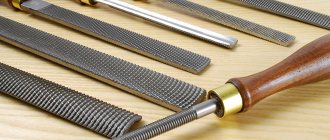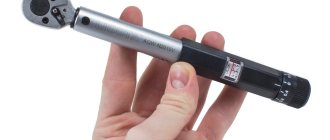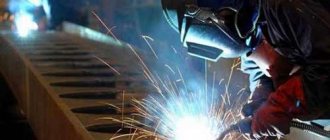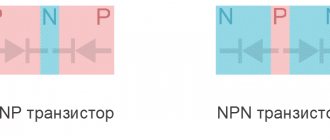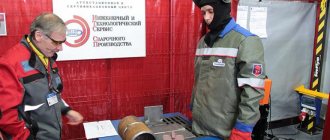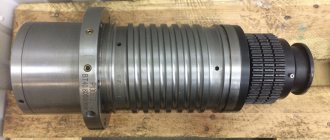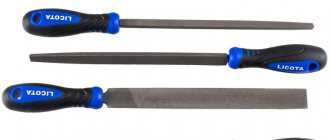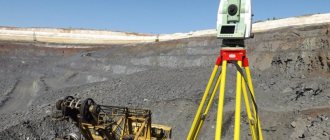How does the certification process take place and what do you need to take with you to the exam?
How to get a NAKS welder? One day is allotted for certification. If you are taking the exam not at an enterprise, but at a plant or institute, then come in the morning and start preparing. After preparation, you are given two pieces of pipe (coil) and you cook them to light. You also need to prepare the edges - chamfering up to 45 degrees, joining pipes (for this there must be a special clamp in the booth), tacking them. It is better to come prepared for certification, with your own tools and consumables. It would be nice to buy a bag in which everything can be compactly packed and transported without any problems. You need to take with you: • 2-3 kilograms of LB 52U Kobelco electrodes with a diameter of 2.6, because they are certified. On the spot you will most likely be offered electrodes, but it is unlikely that they will be LB, they will probably give you Merov’s (MP-3), which cannot be used to weld a seam, or SSSI. Those. It's better to come with your electrodes and ask them to put them in the oven while you train; • a square for centering parts so that they do not move; • slag hammer; • grinder (grinder). Grinding wheels, cutting wheels, metal brush. The pipe must be cleaned to a metallic shine from the inside and outside at a distance of 30 mm from the edges to be welded. • a regular metal brush. • your electrode holder. The holder that will be provided to you on site may be loose and may not hold the electrode. • mask (this is the most important thing). It's better to buy an inexpensive Chameleon. You can purchase it for one time only to pass the exam.
| Read the article on the website: Repairing a chameleon mask with your own hands |
Welding of pipes for NAKS certification under defect control (ultrasound or x-ray)
Preparatory work
As blanks, take two pieces of steel pipe with a diameter of 133 mm and a wall thickness of 4 mm, cut evenly (this can be done most effectively on a miter saw). Make sure that the cut is absolutely even. If it is slightly crooked, then you will encounter quite serious difficulties during the welding process. Next, you need to remove the chamfer with a grinder and clean the edges. The chamfer is removed in accordance with GOST 16037-80 “Welded joints” at a certain angle. The angle on each pipe should be 25-30 degrees.
After that. After the chamfer was removed, it is necessary to clean off the burrs so that they do not interfere with the correct formation of the root of the seam. This is done with a file. After you have removed the chamfer and the burrs inside, you need to make the edges blunt, because an angle that is too sharp will quickly melt during the welding process. According to GOST, blunting is made up to 2 mm.
| Read the article on the website: ESAB OK Electrodes |
Assembly
This step is very important, perform it very carefully. The success of the welded joint will entirely depend on the correct assembly. According to the rules, it is necessary to dock the pipe and grab it. This must be done so that there is an appropriate gap for complete penetration, and there is no displacement. I would also like to note that pipes come with eccentricity (not quite round). Even in such a serious organization as NAKS, pipes can be distributed oval, which will ultimately affect the displacement. According to the rules, 1 mm is allowed, but still this is a lot and there may be no fusion at the root of the seam due to the displacement and ellipticity of the pipes.
To join pipes, take a flat corner or channel, on which they are laid and a gap is set, which can be approximately 2 to 3 mm. This is usually provided by the diameter of the electrode, which is simply inserted into the joint between two pipes. If you are welding with a 2.5 mm electrode. then, accordingly, the gap will be the same.
Note. The root passage of pipes of any diameter (if it is not quite a huge size) is welded only with a 2.5 mm electrode. If you try to brew the root in threes, then nothing good will come of it.
The next point I would like to note. When passing the NAKS certification, you may be provided with pipes up to 10 mm thick to complicate the task. With such thicknesses it is necessary to increase the gap to 3 mm. It is also necessary to take into account and make an error in the fact that when tacking, the pipe may be pulled together at the tacking site by stresses in the metal. Make the gap larger by a few tenths of a millimeter so that there are no difficulties in the future. For more reliable docking, you can also use magnets. They can be fixed on both sides.
Surfacing of tacks
To weld a pipe with a diameter of 133 mm and a wall thickness of 4, you will need an approximate current of 50A, which can be adjusted during operation. The tack is placed first on one side of the pipe, then, respectively, on the opposite side. If necessary, the gap between the pipes is adjusted. The third tack is placed 90 degrees from the first, and the fourth opposite the third.
Tack processing
After installing the tacks, you need to clean them well. At their beginning and end, it is necessary to make cuts to eliminate possible defects (lack of fusion and pores).
Root welding
To effectively perform this task, it is enough to learn how to make just one oscillatory movement “back and forth” with a gradual shift from one tack to another. Welding speed depends on the situation. You can light the electrode on a potholder, using a long arc; the root itself is cooked with a short arc. We cook at an angle back, the electrode can be held at an angle from straight to sharp. If you cut the pipe in half, the bead on the reverse side should look like the one shown in the picture after the operation is completed.
It is convenient to cook by hanging the pipe on the device in the “half-ceiling” position. When you approach the next tack, it is advisable to file it so that there is good fusion at the junction of the rollers. If possible, the process should occur without tearing off the electrode. If separation occurs, then you can add a little current at this moment to ensure penetration. The current is adjusted according to the situation to ensure sufficient penetration and avoid burning through the metal. When welding in a vertical position, you can always keep the current at a minimum; when you reach the lower position, you must take into account that it is easier for liquid metal to fall inside the pipe - be careful not to overheat the steel too much at this moment.
Facing seam
• Before proceeding with the facing pass, you need to clean the root of the seam to bare metal (remove lumps, slag, undercuts). A small groove is made. • It is convenient to weld a facing seam in the ceiling position by moving the electrode in a spiral. • Vertical passage – “crescent-herringbone”. • When welding without breakaway, try to find the most comfortable position for your body and arms, make sure that the torch wire is long enough to perform all the necessary manipulations. • when beating off slag, it is advisable to cover your eyes and face with your hand. • when welding the second bead, it is necessary to make a cut.
Node control
The edges of the seam are cleaned to a distance of about 50 mm (splashes, sagging, etc.) The control itself begins with a visual inspection of the quality of the front seam. However, usually no questions arise for him, which cannot be said about the root pass. If the pipe has passed a visual inspection, only then is it allowed to be examined using non-destructive methods (ultrasound, x-ray).
Facial pass requirements:
• The height of the roller is 0.5 – 2 mm • The width of the roller should be equal to the thickness of the pipe multiplied by 2. If the thickness of the pipe is 4 mm, then the width of the roller should be 8-10 mm. • The seam is smooth, straight, the arrangement of scales is dense.
Root Pass:
• The height of the return roller is 0.5-1 mm. • lack of fusion and lack of penetration are not allowed.
Certification levels
Why do you need a NAKS certificate? Today, its presence is a necessary condition for a specialist to perform welding work. The procedure and rules for certification that a welder undergoes are established by documents developed by NAKS. The procedure is carried out by certification centers, which are regional representative offices of NAKS. The certification commission includes certification experts who are certified and included in the NAKS register of experts, as well as representatives of Rostechnadzor. The received certificate confirms the professional level of the welder to perform specific work.
As part of the certification, the welder goes through several levels:
- Welder;
- Master welder;
- Welding technologist;
- Welding engineer.
Specialists of levels 2, 3 and 4, who are part of the management of enterprise divisions, must undergo mandatory certification. Specialists who need permission to work in hazardous or difficult conditions also undergo mandatory certification.
How to get a certificate
Any specialist who has the appropriate education, qualifications and the necessary professional training can undergo certification.
- The candidate submits an application, documents on education and qualifications, and a certificate of employment to the certification center.
- Within 3 days, makes a decision on approval of the application. If the application is rejected, the certification center will notify you in writing of the reason for rejecting the application.
- Certification of welders consists of testing knowledge of welding theory and practical skills of a specialist. For level 1 certification, the test includes at least 15 theoretical questions; for welders of levels 2, 3 and 4 – at least 20 questions. Theoretical knowledge is tested using a computer or in writing using teaching materials developed by the certification body. An additional interview may also be conducted. The theoretical part is considered passed if the candidate answers 80% of the questions correctly.
- When testing practical skills, they are guided by NAKS and GOST documents, which regulate the conduct of practical tests. The test is passed if the specialist has completed a practical task in accordance with the declared area of certification. A candidate who successfully passes the test is issued a certificate.
- If a candidate fails the theory or practical skills test, he has the right to retake this part within 3 months at the same certification center. A candidate who does not pass the re-test is considered to have failed the certification and receives a written refusal of certification.
- The certificate number of a certified specialist is entered into the NAKS register. Using the registry, you can find out when the certification was carried out, the scope of certification, and the validity period of the document.
For welders the certificate is valid for 2 years, for welding production employees of levels 2 and 3 it is valid for 3 years, for level 4 – 5 years.
Welding certification NAKS. Control instructions
It often happens that in order to carry out installation, repair, production and reconstruction of technical devices at hazardous industrial facilities, the Customer hires a specialized installation organization, the range of services of which also includes welding work.
Before starting welding work, it is necessary to check the permitting documentation of the installation organization. Only after checking the permitting documentation can the installation organization receive permission to begin work. As a rule, the decision on permission to work is made by the technical supervision (construction control) of the Customer. Such a specialist must have the necessary knowledge in the field of welding production, and must also check and pay attention to the presence of the following documents in the process of checking the permitting documentation of the installation organization:
Certificate of NAKS on the readiness of the applicant organization to use certified welding technology in accordance with the requirements of RD 03-615-03
Certification of the NAKS technology confirms the fact that the installation organization has the technical and organizational capabilities, qualified personnel to conduct welding work in accordance with the certified technology, as well as control that the welded joints implemented in the conditions of a specific production using the certified technology comply with the requirements of regulatory documentation to hazardous production facilities.
Just having a welding certification certificate is not enough. It is important to pay attention to what welding method and what group of technical devices it is issued. It is also necessary to check the validity period of the certificate.
If necessary, the authenticity of the certificate can be checked on the NAKS website, where by the certificate number or the name of the organization you can find out whether the certificate is included in the NAKS register or not.
It is important to remember that an annex must be prepared for the certificate, which contains the following data about the established scope of the production certification of the technology:
- welding method
- nature of the work performed (manufacturing, installation, repair and reconstruction)
- groups and brands of basic materials
- welding materials
- diameter range
- thickness range
- seam type
- connection type
- type of connection
- cutting angle
- welding position
- presence of heating
- presence of heat treatment
- type of electrode coating
Based on this annex to the certificate, it is necessary to assess the ability of the installation organization to carry out a set of welding works provided for by the working documentation or the welding production project (WPP).
Certificate of certification of welding equipment in accordance with the requirements of RD 03-615-03
Certification of welding equipment by NAKS is carried out to check the ability of the equipment to provide specified technological characteristics for various welding methods, which determine the required quality of welded joints in the manufacture, installation, repair and reconstruction of technical devices used at hazardous production facilities.
During the verification of this certificate, first of all, it must be revealed that the serial number on the welding equipment corresponds to the number specified in the equipment certification certificate. The name and brand of the equipment must also match.
Also, in the certificate of certification of welding equipment, it is necessary to check the compliance of groups of technical devices for compliance with the facility at which welding work is carried out (GO, GDO, KO, KSM, MO, NGDO, OTOG, OKHNVP, PTO, SK). Simply put, is the presented welding machine suitable for carrying out work, for example, on the installation of boiler equipment.
The type of welding assumed and specified in the working documentation or welding work project (RD, RAD, MP, etc.) must correspond to that specified in the certification certificate.
The validity period of the certificate is also subject to mandatory control. Equipment with expired certification certificates are not allowed to perform work.
The authenticity of welding equipment certification can be checked on the NAKS website.
Welding production specialist certification certificate
Certification of welders NAKS is a set of documents, according to which a welder is allowed to work at hazardous production facilities. It is worth noting that work carried out at hazardous production facilities must be performed not only by certified welders, but also under the supervision of a level II or III welding specialist. Uncertified personnel cannot be allowed to carry out work.
Welding production specialists have the following certification levels:
Level I – welders who have the right to perform welding work using specific welding methods, both manually and by mechanized or automated methods.
Level II – specialists (craftsmen, work producers) who have the right to give instructions to welders in written or oral form, as well as to exercise guidance and technical control during the welding process.
Level III – specialists (technological engineers, laboratory employees) who provide, as well as carry out management and technical control of welding work. Level III welding production specialists have the right to develop and sign production and technological documentation for welding work (welding production projects and technological maps).
Level IV – specialists who are the managers of the enterprise’s welding service (chief welder), who provide management and technical control of welding work, and also have the right to develop and approve guidelines and regulatory documents for the performance of all types of welding work.
It often happens that checking the documents of welding production specialists is limited only by their availability. But no one pays attention to which hazardous production facility was certified by NAKS. It is important to remember that a specialist certified in gas equipment (GO) does not have the right to carry out work on the installation of oil and gas production equipment (OGPE).
The certificate of a welding production specialist must be accompanied by a certification protocol. The protocol contains information about the groups of dangerous technical devices for which the specialist is certified, as well as the name of the organization in which the specialist worked at the time of certification. The certificate will be valid even if the specialist changes his place of work several times.
In addition to the NAKS certificate, a welding production specialist must be certified according to safety rules in Rostekhnadzor for hazardous production facilities specified in the certificate.
Certified welders must have a certificate of the established form, which reflects and must verify the following data:
- type of welding (RD, RAD, MP, etc.)
- type of parts (T - pipe, L - sheet, T+L - pipe + sheet)
- types of seams (SSh - butt weld, USH - fillet weld)
- group of welded material (M01, M02, etc.)
- welding materials
- thickness of parts
- outside diameter
- welding position
- type of connection
Certified welders are allowed to perform welding work at hazardous production facilities in accordance with RD 03-495-02 and PB-03-273-99.
It is not uncommon for installation organizations, in order to save money, to have only one certified specialist or not at all. Thus, they are forced to illegally attach other people’s copies of certificates of specialists, often not working in this organization, and sometimes even forged certificates. Therefore, the authenticity of the ID must be verified on the NAKS website.
Certificate of certification of welding materials in accordance with the requirements of RD 03-615-03
When checking the quality of welding materials, it is necessary to pay attention not only to the availability of certificates, but also to the presence of a NAKS certificate of certification of welding materials.
Such certification is necessary to verify the compliance of the actual technological properties and characteristics of welding materials with the properties and characteristics specified in the accompanying documentation and the requirements of current standards, technical specifications and other regulatory documents for welding materials. Based on the certification results, the possibility of using welding materials during installation work is determined in accordance with the declared welding technology.
The certification certificate for welding materials contains the following data:
- brand of welding materials
- standard size (diameter)
- welding method (RD, RAD, MP, etc.)
- groups of basic materials (M01, M02, etc.)
- groups of technical devices (KO, GO, SK, OKHNVP, etc.)
The type or brand of welding materials must correspond to those specified in the working (design) documentation or the welding project. It is also necessary to check the validity period of the NAKS certification. Typically, the validity period is 3 years.
The authenticity of the certificate of certification of welding materials can be checked on the corresponding page of the NAKS website. The certificate must be entered in the NAKS register.
